Content is from Kirkbride et al. 2006Kirkbride et al. 2006:
Kirkbride JH, Jr, Gunn CR, and Dallwitz MJ. 2006. Family guide for fruits and seeds, vers. 1.0. Accessed September 2020-January 2022. URL: https://nt.ars-grin.gov/seedsfruits/keys/frsdfam/index.cfm ., without modification.
Updates are forthcoming.
Fruits: Pistil(s) compound; 1; 1-pistillate; with carpels united. Fruit pericarpium; simple; capsulecapsule:
a dry, dehiscent fruit derived from a compound ovary , or carceruluscarcerulus:
, or carceruluscarcerulus:
simple, multicarpellate, indehiscent fruit consisting of one or more seeds and air space enclosed by an undifferentiated pericarp (Spjut 1994)
(Pararistolochia), or folliclefollicle:
a dry to (rarely) fleshy fruit derived from a single carpel that opens along a single longitudinal suture, derived from a single, superior, simple ovary; the seeds may be arillate or with a fleshy testa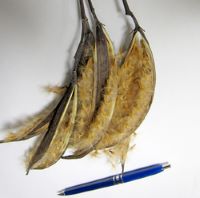 (Saruma); ceratium capsulecapsule:
(Saruma); ceratium capsulecapsule:
a dry, dehiscent fruit derived from a compound ovary (Aristolochia Spjut, Figs. 18E & 19A), or septicidalsepticidal:
(Aristolochia Spjut, Figs. 18E & 19A), or septicidalsepticidal:
type of capsular dehiscence, opening longitudinally by separating between the septa of adjacent carpels
 capsulecapsule:
capsulecapsule:
a dry, dehiscent fruit derived from a compound ovary (Holostylis); capsulecapsule:
(Holostylis); capsulecapsule:
a dry, dehiscent fruit derived from a compound ovary not inflated; capsulecapsule:
not inflated; capsulecapsule:
a dry, dehiscent fruit derived from a compound ovary without operculumoperculum:
without operculumoperculum:
a dehiscent cap (or lid) of a seed or fruit that opens during germination or dehiscence ; without persistent central column; crowned by rim (calyptra scar), or sepals; not within accessory organ(s); 1-seeded to many-seeded; with 2–6-carpellate ((3–5)); with carpels united; with carpels remaining united at maturity; without sterilesterile:
; without persistent central column; crowned by rim (calyptra scar), or sepals; not within accessory organ(s); 1-seeded to many-seeded; with 2–6-carpellate ((3–5)); with carpels united; with carpels remaining united at maturity; without sterilesterile:
lacking male and/or female reproductive parts; also, not producing fruit or seed
 carpels; sulcatesulcate:
carpels; sulcatesulcate:
surface relief—having one or more elongate, relatively narrow and shallow depressions or grooves ; in transection angledangular:
; in transection angledangular:
2D shape—having sides that meet at acute or obtuse angles
, or tereteterete:
approximately circular in cross section; width and thickness approximately equal
 , or cruciform (Thottea); 4-angled; apexapex:
, or cruciform (Thottea); 4-angled; apexapex:
the point farthest from the point of attachment, or the "tip" of an organ not beaked; dehiscentdehiscent:
not beaked; dehiscentdehiscent:
(v. dehisce) splitting open at maturity to release contents (of a fruit) , or indehiscentindehiscent:
, or indehiscentindehiscent:
not opening on its own, as in a fruit
 (rarely). Dehiscentdehiscent:
(rarely). Dehiscentdehiscent:
(v. dehisce) splitting open at maturity to release contents (of a fruit) unit seed(s). Dehiscentdehiscent:
unit seed(s). Dehiscentdehiscent:
(v. dehisce) splitting open at maturity to release contents (of a fruit) regularly; passively; linearly; by dorsaldorsal:
regularly; passively; linearly; by dorsaldorsal:
abaxial; the back of an organ; the side away from the axis (compare ventral)
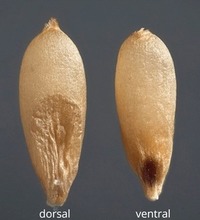 sutures and ventralventral:
sutures and ventralventral:
adaxial; of the side of an organ facing the axis (compare dorsal)
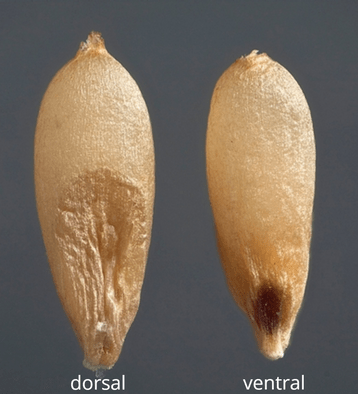 sutures; at apexapex:
sutures; at apexapex:
the point farthest from the point of attachment, or the "tip" of an organ , or base (Thottea); and shedding seeds; without replumreplum:
, or base (Thottea); and shedding seeds; without replumreplum:
the rim, formed by the persistent placentas, and connected by a false septum in Brassicaceae fruits. The fruit valves are attached to this rim and separate from it in dehiscent fruits.
. Epicarpepicarp:
outer layer of fruit wall or pericarp, if divided into layers; note here used synonymously with exocarp durable; without armature; not smooth; ribbedribbed:
durable; without armature; not smooth; ribbedribbed:
surface relief—wide, prominent, linear ridges that are generally rounded and longitudinally situated on the surface ; without wing(s); without apicalapical:
; without wing(s); without apicalapical:
at or pertaining to the end of the seed or fruit distal from its point of attachment (i.e., base)
respiratory hole. Mesocarpmesocarp:
the middle layer of the pericarp, if divided into layers absent. Endocarpendocarp:
absent. Endocarpendocarp:
the inner layer of the pericarp, if divided into layers present; not separating from exocarpexocarp:
present; not separating from exocarpexocarp:
outer layer of fruit wall or pericarp, if divided into layers; note here used synonymously with epicarp ; thin, or fleshy; not splitting into 1-seeded pyrenes; smooth, or not smooth; with ribs; without operculumoperculum:
; thin, or fleshy; not splitting into 1-seeded pyrenes; smooth, or not smooth; with ribs; without operculumoperculum:
a dehiscent cap (or lid) of a seed or fruit that opens during germination or dehiscence ; without secretory cavities; without longitudinallongitudinal:
; without secretory cavities; without longitudinallongitudinal:
of or relating to length or the lengthwise dimension
ridges. Funiculusfuniculus:
(alt. funicle) stalk connecting the ovule (later seed) to the ovary (later fruit) placenta short; short without seed bearing hookswith hooks:
short; short without seed bearing hookswith hooks:
bristles or spines with curved or backwards pointing tips, or with secondary bristles along their length (retinacula); not persisting in fruit after seed shed.
(retinacula); not persisting in fruit after seed shed.
Seeds: Arilaril:
(broad sense) appendicular structure that wholly or partly envelops a seed and is produced from or a modification of the funicle, raphe, or outer integument; usually fleshy or pulpy, sometimes spongy or tufted-capillate, often brightly colored absent, or present; an arillike structure. Arillike structure falling with seed an elaisome (Asarum canadensis L.). Seed larger than minute (from a few mm); triangulartriangular:
absent, or present; an arillike structure. Arillike structure falling with seed an elaisome (Asarum canadensis L.). Seed larger than minute (from a few mm); triangulartriangular:
2D shape—three relatively straight sides with distinct corners; more angular than teardrop-shaped , or C-shapedC-shaped:
, or C-shapedC-shaped:
2D-shape—semiannulate, curved into the shape of the letter 'C'
, or ellipsoidellipsoid:
3D shape—elliptic
, or oblongoblong:
2D shape—much longer than broad with nearly parallel sides, corners are rounded , or ovateovate:
, or ovateovate:
2D shape—egg-shaped in outline, widest point is towards one end of the organ, the other end tapers gradually, attachment at or near the broad end (compare obovate, ovoid) (broadly); in transection triangulartriangular:
(broadly); in transection triangulartriangular:
2D shape—three relatively straight sides with distinct corners; more angular than teardrop-shaped , or flattened (rarely); not bowl shaped, or bowl shaped; not nutlike; without winglike beakbeak:
, or flattened (rarely); not bowl shaped, or bowl shaped; not nutlike; without winglike beakbeak:
a usually firm, terminal appendage, sometimes tapered ; without caudatecaudate:
; without caudatecaudate:
tapering to a long, tail-like appendage appendage(s); at maturity with food reserves; with endosperm; without canavanine. Sarcotestasarcotesta:
appendage(s); at maturity with food reserves; with endosperm; without canavanine. Sarcotestasarcotesta:
pulpy or fleshy outer layer of the seed coat, simulates aril absent. Testatesta:
absent. Testatesta:
seed coat
 present; without fleshy or leatheryleathery:
present; without fleshy or leatheryleathery:
texture—moderately thick, tough, and very pliable
layer over hard layer; surface unsmooth, or smooth (rarely); surface with depressed features, or discreet raised features, or merged raised features; surface groovedgrooved:
surface relief—linear depressions that may be single or form a series of grooves over the surface ; surface tuberculatetuberculate:
; surface tuberculatetuberculate:
surface relief—bearing small, warty, swelling, rounded, or variously shaped projections , or warted, or granulargranular:
, or warted, or granulargranular:
surface relief—having a grainy surface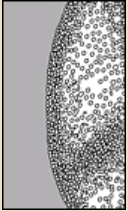 (sparsely & rarely); surface rugoserugose:
(sparsely & rarely); surface rugoserugose:
wrinkled , or corrugate (Thottea siliquosa (Lam.) Ding Hou), or rugoserugose:
, or corrugate (Thottea siliquosa (Lam.) Ding Hou), or rugoserugose:
wrinkled (transversely Asarum canadense L.); without crease or line separating cotyledons from hypocotyl-radicle; without notch along margin where cotyledons from hypocotyl-radicle tip approach each other; without glands; without bristles; glabrousglabrous:
(transversely Asarum canadense L.); without crease or line separating cotyledons from hypocotyl-radicle; without notch along margin where cotyledons from hypocotyl-radicle tip approach each other; without glands; without bristles; glabrousglabrous:
without hairs
; with wing(s), or without wings; 1-winged; with wing encompassing seed; without collar; without operculumoperculum:
a dehiscent cap (or lid) of a seed or fruit that opens during germination or dehiscence ; colored; monochrome; brown (all shades); crustaceouscrustaceous:
; colored; monochrome; brown (all shades); crustaceouscrustaceous:
texture—thin, dry, indurate, and brittle
, or hard; not becoming mucilaginousmucilaginous:
resembling mucilage; moist and sticky
when wetted; surrounding food reserve. Rapheraphe:
a ridge or seam on the seed coat, formed by the portion of the funiculus united to the ovule wall in longitudinally curved ovules conspicuous; corkycorky:
conspicuous; corkycorky:
firm, relatively light, discontinuous but strongly cohesive, and resilient
(including those shaped like a fungus); as long as seed, or longer than seed. Endosperm development cellular; copious; fleshy-firm, or fleshy-soft, or hard (or sub-sub-:
a prefix meaning slightly, somewhat, or nearly (used with a descriptive term), or below (used with an anatomical term)
), or fleshy; smooth; with starch, or without starch; with oils; without fatty acid containing cyclopropene; without apicalapical:
at or pertaining to the end of the seed or fruit distal from its point of attachment (i.e., base)
lobes; without chlorophyll; without isodiametric faceted surface; without odor. Embryo differentiated from food reserve, or undifferentiated from food reserve; well developed, or rudimentaryrudimentary:
(of embryo) embryo is small and fills less than a quarter of the seed and can be variable in shapes, such as linear, spatulate, or oval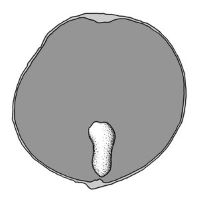 (classified as linearlinear:
(classified as linearlinear:
(shape) long, narrow, and uniform in width; (of embryo) embryo is straight and much longer than wide but tiny and basalbasal:
but tiny and basalbasal:
at or pertaining to the point of attachment; (of embryo) embryo occupies one end of the seed
); 1 per seed; partially filling testatesta:
seed coat
 (with food reserve); 0.05–0.2 times the length of food reserve; at one end of seed not extending into a depression or cup; axileaxile:
(with food reserve); 0.05–0.2 times the length of food reserve; at one end of seed not extending into a depression or cup; axileaxile:
on or of the axis
and centric, or basalbasal:
at or pertaining to the point of attachment; (of embryo) embryo occupies one end of the seed
; linearlinear:
(shape) long, narrow, and uniform in width; (of embryo) embryo is straight and much longer than wide ; straight; without coleorhiza; without simmondsin; without stomata; not green; with 2 or more cotyledons, or acotyledonous. Cotyledons 2; tiny; 0.4 times length of embryo; as wide as hypocotyl-radicle; smooth; equal in size; not punctatepunctate:
; straight; without coleorhiza; without simmondsin; without stomata; not green; with 2 or more cotyledons, or acotyledonous. Cotyledons 2; tiny; 0.4 times length of embryo; as wide as hypocotyl-radicle; smooth; equal in size; not punctatepunctate:
surface relief—dotted with pits or with translucent, sunken glands or with colored dots, similar to pitted dotted. Hypocotyl-radicle vestigial, or moderately developed; straight; not thickened. Plumule undeveloped.
dotted. Hypocotyl-radicle vestigial, or moderately developed; straight; not thickened. Plumule undeveloped.
Literature specific to this family: Hou, D. 1981. Florae malesianae praecusrores. LXII. On the genus Thottea (Aristolochiaceae). Blumea 27:301–332; Huber, H. 1985. Samenmerkmale und Gliederung der Aristolochiaceen. Bot. Jahrb. Syst. 107:277–320.
General references: Corner, E.J.H. 1976. The seeds of Dicots, esp. vol. 2. Cambridge University Press, New York, Cronquist, A. 1981. An integrated system of classification of flowering plants, 1,262 p. Columbia University Press, New York, Gaertner, J. 1788–1805. De fructibus et seminibus plantarum. The Author, Stuttgart, Goldberg, A. 1986 (dicots) & 1989 (monocots). Classification, evolution, and phylogeny of the familes of Dicotyledons. Smithsonian Contr. Bot. 58 for dicots (314 pp.) & 71 for monocots (74 pp.). [Goldberg's illustrations are reproduced from older publications and these should be consulted], Gunn, C.R. & C.A. Ritchie. 1988. Identification of disseminulesdisseminule:
detachable plant part capable of being disseminated and of propagating, commonly a seed or fruit
listed in the Federal Noxious Weed Act. Techn. Bull. U.S.D.A. 1719:1–313, Gunn, C.R., J.H. Wiersema, C.A. Ritchie, & J.H. Kirkbride, Jr. 1992 & amendments. Families and genera of Spermatophytes recognized by the Agricultural Research Service. Techn. Bull. U.S.D.A. 1796:1–500, Mabberley, D.J. 1987. The plant-book, 706 p. Cambridge University Press, Cambridge, Martin, A.C. 1946. The comparative internal morphology of seeds. Amer. Midl. Naturalist 36:513–660, Spjut, R.W. 1994. A systematic treatment of fruit types. Mem. New York Bot. Gard. 70:1–182, and Wood, C.E., Jr. 1974. A student's atlas of flowering plants: Some dicotyledons of eastern North America, 120 pp. Harper & Row, New York.